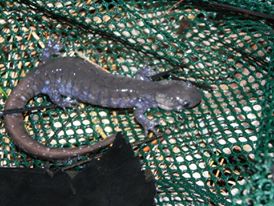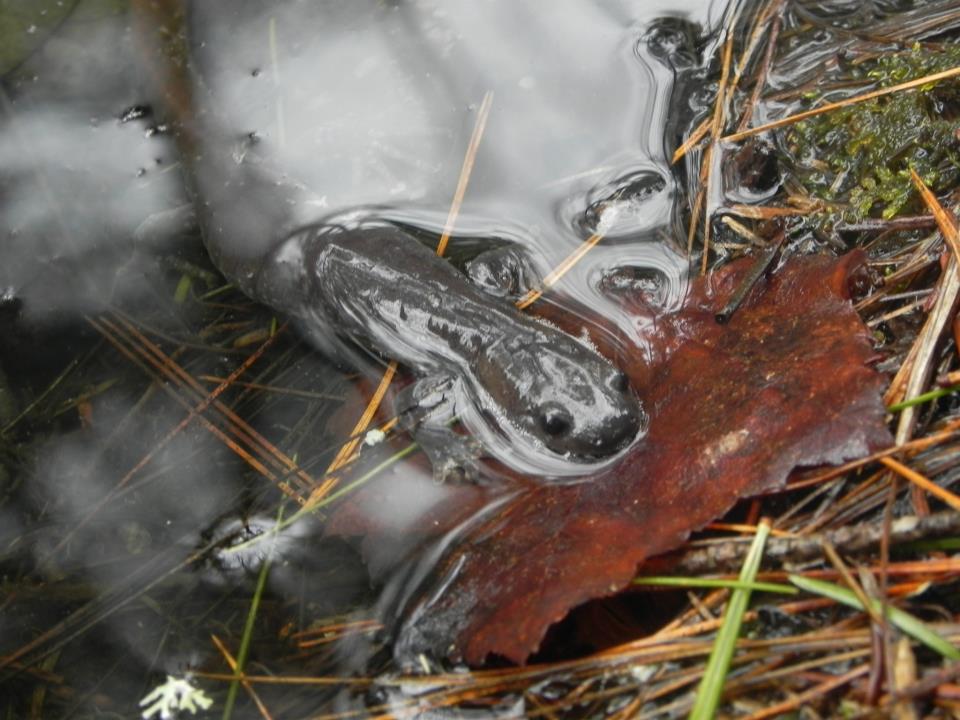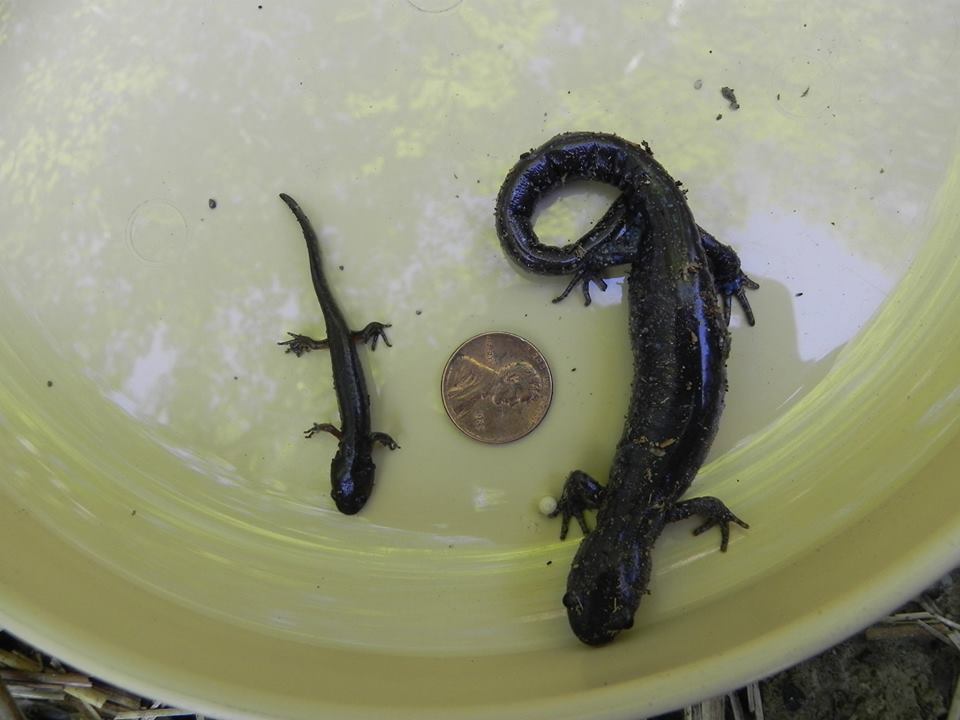
A Unisexual Salamander caught in a dip net. These salamanders are visually similar to Blue-Spotted Salamanders.
Kris Hoffmann, Graduate Researcher, University of Maine
I get a lot of puzzled looks when I tell people I study Unisexual Salamanders. Many Mainers know of Blue-Spotted Salamanders, and some folks have even heard of the Blue-Spotted Salamander Complex, but usually they don’t know much about Unisexuals because they are, well, very complex. Unisexuals are truly unique, as their biology is different not just from all the other salamanders in Maine, but from all other vertebrates on Earth.
Are you ready for a story full of strange biological twists?
Twist #1: Unisexuals evolved from hybrids
About 5 million years ago, before the current salamanders existed, there were ancient species of salamanders. Two of these species visited the same wetland to breed, and by chance they mated. Unlike mules, their hybrid offspring were able to reproduce. The descendents of this hybrid evolved into the Unisexuals we have today. Our modern Unisexuals are not considered hybrids themselves; they have been evolving on their own long enough that they are the equivalent of a species.

Unisexuals Salamanders lay their eggs in vernal pools, and use Blue-Spotted Salamander sperm to stimulate their eggs to develope.
Twist #2: Unisexual tend to clone themselves
The hybrid origin of Unisexuals caused some strange things to happen to during reproduction. Their chromosomes came from different species, so Unisexuals are not able to undergo normal cell division where half of their DNA would go into one gamete (egg or sperm) and the other half would go into another. Instead Unisexuals usually put all of their DNA into each gamete. Since the DNA of the egg is already complete, the DNA from sperm is not needed by the offspring. Sperm is needed to stimulate the eggs to divide, but it often does not contribute to the DNA of the offspring. When the sperm’s DNA is not incorporated, the offspring is a clone of her mother.
Twist #3: Unisexuals are all female, hence the name
Since the mother passes on all of her genes, she passes on all of her sex chromosomes. These specific bits of DNA are responsible for determining if the offspring will be a male or female. In mammals, the presence of a Y chromosome determines what biological sex you are. If you have one Y then you are a male (XY) and if you have no Y then you are a female (XX). You might sometimes see the Y chromosome referred to as the male chromosome. In amphibians the presence of the W chromosome determines sex, but W is a female chromosome. If a salamander has one W then it is a female (WZ) and if it has no W then it is a male (ZZ). So when the female Unisexual passes all her genes onto every egg, all of her offspring will have a W and they will all be female.
Twist #4: Unisexuals are sperm parasites
Amphibians need sperm to stimulate their eggs to develop, but there are no male Unisexuals. In order to reproduce the Unisexuals must “steal” sperm from another species. In Maine, they take sperm from Blue-Spotter Salamanders (Ambystoma laterale), but they can use the sperm of other species in different parts of their range (i.e., Jefferson Salamanders, Ambystoma jeffersonianum, in Massachusetts).
Twist #5: Unisexuals have more than 2 copies of DNA
Most animals are diploid, meaning they have two copies of all their genes. One copy comes from mom and one copy comes from dad. Unisexuals get multiple copies from mom, and sometimes get a copy from dad. When this happens, the offspring has more copies that her mother. Most Unisexuals in Maine have 3 or 4 copies, but they can fit up to 5 copies in their cells.

A newly metamorphed Unisexual Salamander and an adult Unisexual Salamander.
Twist #6: Maine’s Unisexuals are part Blue-Spotted Salamander and part Jefferson Salamander
Over the millennia, the original DNA of the extinct ancestor species was replaced by DNA from modern sperm donor species. In Maine, all of our Unisexuals have at least 2 copies of Blue-Spotted genes because that is the species that donates sperm. However, our Unisexuals are also part Jefferson, even though Jefferson salamanders do not live in Maine.
Twist #7: Unisexuals tend to look nearly identical to their sperm donors.
A Unisexual Salamander with two part Blue-Spotted Salamander DNA and one part Jefferson Salamander DNA can look identical to an actual Blue-Spotted Salamander. Together, we call these animals “The Blue-Spotted Salamander Complex.” We can only reliably tell the Unisexuals and Blue-Spots apart using genetic methods or by measuring the size of their blood cells. (Unlike mammal blood, amphibian blood cells contain DNA. The more DNA in the cell, the bigger it is.)
That’s 7 ways that Unisexuals are different from other Maine amphibians. Their ability to sometimes incorporate “stolen” sperm and other times clone themselves is what separates them from all the other vertebrates. They are truly unique, and a fun and complicated puzzle.
